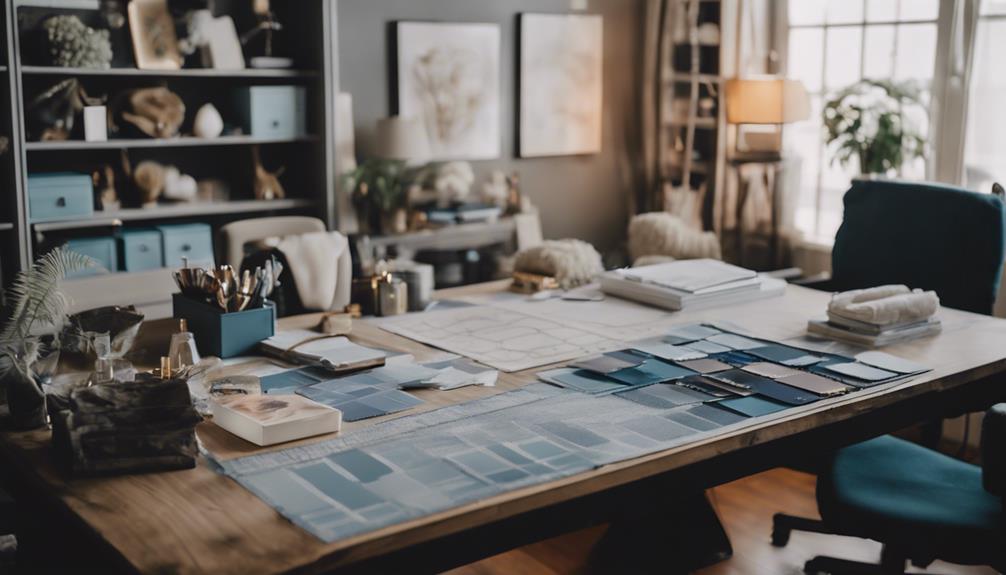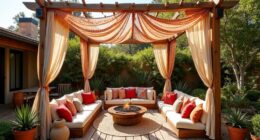When you're choosing between interior styling and interior design, think about what excites you most. Interior design involves creating functional spaces and typically requires a degree and licensing. You'll tackle structural changes and manage larger projects. In contrast, interior styling focuses on aesthetics through color and furnishings, often without formal education or certification. It's more about enhancing existing spaces with creative decorations. Your decision should reflect your skills and interests. If you want to explore the challenges, financial aspects, and market trends of each path, you'll find valuable insights that can guide your choice.
Key Takeaways
- Interior design requires formal education and certification, while interior styling can be pursued with little to no formal training.
- Designers focus on functional layouts and structural changes, whereas stylists enhance visual appeal without altering existing structures.
- The earning potential in interior design can be inconsistent, while home staging offers quicker financial returns with substantial income potential.
- Designers must adhere to building codes and use CAD software, whereas stylists emphasize aesthetics and creativity without technical software requirements.
Understanding Interior Design
Interior design is all about creating functional and visually appealing spaces that meet specific needs and preferences. As you explore the world of interior design, you'll find that interior designers play an essential role in transforming environments. They utilize their skills to plan layouts, select materials, and guarantee compliance with building codes and regulations.
To become an effective designer, you'll likely need to complete an Interior Design program, which provides fundamental knowledge and training. In this program, you'll learn to use computer-aided design (CAD) software for creating schematic drawings and renderings. This skill is important for communicating your ideas clearly to clients and contractors.
It's also important to note that many states require interior designers to obtain licensure, underscoring the significance of formal education in the field. Interior designers typically tackle larger projects involving structural changes, collaborating closely with architects and other professionals.
Exploring Interior Styling

Styling a space is all about enhancing its visual appeal, using carefully chosen colors, furniture, and decorative elements to create a cohesive and inviting atmosphere. Unlike interior designers, who often focus on structural changes and larger projects, interior styling emphasizes the aesthetic without the need for formal education or certification. This accessibility makes it an appealing option for many aspiring creatives.
As an interior stylist, you typically work on smaller projects, honing in on the visual aspects of a space. Your role involves selecting the right pieces to transform a room and create a specific mood. Networking and building a strong portfolio are essential for success; many stylists grow their clientele through referrals and showcasing their work online.
The demand for home staging services has also increased, making interior styling a lucrative career path. By preparing homes for sale or enhancing existing spaces, you can earn significant income while helping clients realize their vision. If you're passionate about aesthetics and enjoy working with colors and decor, exploring interior styling could be the perfect fit for you.
Key Differences Explained

Understanding the distinctions between interior design and interior styling can help you choose the right path for your creative aspirations.
An interior designer focuses on creating functional and aesthetically pleasing spaces through structural modifications. This role typically requires formal education, often a bachelor's degree, and licensing in many states.
In contrast, an interior decorator, or stylist, emphasizes the visual appeal of spaces without making structural changes, relying on experience and a keen eye for aesthetics.
When considering the interior designer vs decorator dynamic, note that designers often tackle larger projects, such as residential, commercial, or healthcare spaces, while decorators handle smaller, more cosmetic updates.
Designers utilize tools like CAD software for detailed plans and must adhere to building codes. Decorators, on the other hand, concentrate on selecting color schemes, furniture, and decorative elements without the same regulatory constraints.
Both design career paths enhance living environments but differ greatly in their educational and regulatory frameworks.
If you're drawn to the technical aspects and enjoy structural creativity, interior design might be your calling. If you prefer the aesthetic touch and a more flexible approach, interior styling could be the right fit.
Career Paths Comparison

When you're considering a career in interior design or decorating, it's important to look at the educational requirements and job responsibilities for each path.
Interior designers typically need formal education and licensing, while decorators can often enter the field without such credentials.
Understanding these differences can help you choose the right direction for your career.
Educational Requirements and Licensure
What sets apart the educational requirements and licensure for interior designers compared to interior decorators?
As an aspiring interior designer, you typically need a bachelor's degree in interior design or architecture. This formal education provides you with both theoretical knowledge and practical skills, including business training.
In contrast, interior decorators can often enter the field without any formal education, relying instead on their experience and understanding of design principles.
When it comes to licensure, many states require interior designers to obtain certification, usually by passing the National Council for Interior Design Qualification (NCIDQ) exam. This licensure guarantees that you meet industry standards and stay informed about current trends.
On the other hand, interior decorators don't need such certification, which allows for a more accessible entry into the field.
While continuing education is vital for interior designers to maintain licensure and stay updated, decorators can enhance their skills through workshops or self-directed learning.
If you're considering specialization within interior design, be aware that additional certifications may be necessary, whereas decorators typically don't face specialized licensing requirements.
Job Responsibilities and Focus
Interior designers and decorators take on distinct job responsibilities, with designers focusing on functional layouts and structural changes, while decorators enhance existing spaces' aesthetics. If you're considering an interior design career path, it's crucial to understand these differences.
Here's a quick comparison of their job responsibilities:
- Interior Designers: They create functional layouts, making structural alterations, and must adhere to building codes and safety standards.
- Interior Decorators: They select colors, furnishings, and decorative elements to improve visual appeal without structural changes.
- Project Management: Designers often oversee larger projects, coordinating with contractors and managing timelines; decorators usually handle smaller, cosmetic updates.
- Technical Skills: Designers use CAD software for detailed planning, while decorators focus on aesthetics without needing technical design software skills.
Education and Training Requirements

A solid foundation in education and training is essential for anyone aiming to excel in interior styling or design. For aspiring interior designers, obtaining a bachelor's degree in interior design or architecture is important. Look for programs accredited by the Council for Interior Design Accreditation (CIDA) to guarantee credibility in your education.
Many states also require licensure for interior designers, which involves passing the National Council for Interior Design Qualification (NCIDQ) exam.
On the other hand, interior decorators may not need formal education, but taking courses on design principles can greatly enhance your skills and marketability. Regardless of your chosen path, continuing education is critical. It helps you stay updated on industry trends and maintain any necessary licensure or certifications.
Additionally, pursuing specialized training in areas like sustainable design, lighting, or home staging can provide you with extra career opportunities and broaden your skill set.
Skills for Success

To succeed in interior styling or design, you need a strong set of essential design skills, including an eye for aesthetics and proficiency in design software.
Networking and collaboration with industry professionals can open doors and enhance your knowledge.
Essential Design Skills
Mastering essential design skills is key to succeeding in the competitive fields of interior styling and design. If you're pursuing a career as an interior professional, focus on honing these critical abilities:
- Understanding Design Principles: Grasp color theory, spatial awareness, and materials selection to create functional and visually appealing spaces.
- Practical Decoration Skills: Develop hands-on experience in decoration and staging, allowing you to merge aesthetics with client preferences and project goals effectively.
- Attention to Detail: Cultivate a keen eye for detail and good taste, which helps you curate harmonious environments that resonate with your clients.
- Ongoing Education: Stay updated on design trends and techniques through workshops and online courses. This commitment enhances your professional credibility and keeps your skills sharp.
Networking and Collaboration
Building strong connections within the interior design and styling community is essential for accessing new opportunities and advancing your career. Networking with industry professionals, such as real estate agents and contractors, can lead to valuable referrals and potential collaborations that boost your prospects. By participating in local design groups and community forums, you gain insights and support, plus access to job postings shared within trusted networks.
Collaboration is another key aspect of success in this field. Working with photographers and artists can elevate your project presentations and diversify your portfolio, showcasing your unique skills and styles. Attending workshops and industry events is a fantastic way to meet mentors and peers, facilitating the exchange of ideas and best practices that can enhance your career growth.
Additionally, building a robust online presence through social media and professional platforms enhances your visibility and attracts clients. It also serves as a powerful tool for networking with other design professionals.
Market Trends and Opportunities

In today's evolving market, the demand for home staging services is surging as more interior designers recognize its profitability and quick turnaround times. This trend aligns with broader market trends in interior design, making it a lucrative path for your career.
As home staging becomes more prevalent, you can capitalize on opportunities that cater to the real estate sector. Here are four key trends to examine:
- Sustainable Design: There's a growing interest in eco-friendly practices. You can attract clients by incorporating sustainable materials and designs.
- Technology Integration: Use tools like virtual reality and 3D modeling to enhance your presentations. Clients appreciate innovative visualization methods.
- Multifunctional Spaces: With remote work on the rise, homes are evolving. Focus on designing spaces that serve multiple purposes for work and leisure.
- Faster Sales: Staged homes sell quicker and at higher prices. This trend emphasizes the effectiveness of your services in the real estate market.
Challenges in Each Field

When exploring the challenges in interior styling and design, you'll quickly notice that time commitment can be a major hurdle.
Interior designers often struggle with creative freedom due to client demands, while home stagers enjoy more flexibility but face their own set of pressures.
Additionally, income stability can vary greatly between the two fields, impacting your career choices and financial growth.
Time Commitment Challenges
Time commitment challenges vary greatly between interior design and home staging, as the former often demands years of study and extensive project timelines, while the latter allows for quicker turnarounds and flexibility for those juggling other responsibilities.
If you're considering these paths, here are some key points to keep in mind:
- Study Interior Design: You'll typically need 2 to 4 years of full-time education, which can be tough if you have family or work obligations.
- Project Timelines: Interior design projects often involve lengthy decision-making processes and client revisions, extending timelines considerably.
- Cost of Education: High tuition costs and potential income loss during your studies can deter many from pursuing interior design.
- Entry into Home Staging: Experienced home stagers often rely on practical experience, allowing them to enter the field without the long-term time commitment of formal education.
Ultimately, if you're looking for a career that offers flexibility and quicker results, home staging might be the better fit.
On the other hand, if you're ready to invest time and effort into a more in-depth career, interior design could be the path for you.
Creative Freedom Limitations
Steering creative freedom can be a significant challenge in both interior design and home staging, as each field presents unique constraints that influence how professionals express their vision.
As an interior designer, you might encounter creative freedom limitations due to client expectations and strict building codes. These regulations can stifle your innovative design choices, leading to frustration when clients alter your carefully crafted spaces after completion. This not only impacts your original vision but can also create conflicts over design integrity.
In contrast, home stagers often enjoy greater creative control. You focus on aesthetics for immediate appeal, primarily working with existing furnishings, which can lead to varied and dynamic projects. However, even in staging, you might still face some constraints based on client preferences and budget restrictions.
Additionally, the competitive nature of the interior design field can limit your opportunities for individual expression. You may find yourself competing on price rather than creativity, particularly in retail settings. While interior decorators often work on smaller projects with less structural involvement, they still grapple with client expectations and budget constraints, which can also hinder their creative expression.
Balancing these challenges is essential for success in either path.
Income Stability Concerns
Income stability is a significant concern for both interior designers and home stagers, as each field presents unique financial challenges. As you consider your career path, it's crucial to understand how each profession can impact your financial well-being.
Project-Based Work: Interior designers often face inconsistent income due to project-based work, with starting salaries averaging around $43,000, which can fluctuate based on market demand.
Real Estate Dependency: Home stagers rely heavily on the real estate market, and while successful stagers can earn up to $10,000/month during peak seasons, income can dwindle during slower periods.
Job Availability: Many interior designers find themselves in sales roles instead of design, leading to lower income stability and potential dissatisfaction in their careers.
Education Costs: The high cost of education and licensing for interior designers can create financial burdens, making it harder to achieve consistent income, especially early on.
Financial Considerations

When comparing interior design and home staging, financial considerations play a crucial role in determining the best career path for you.
Interior design typically requires a formal education that spans four years, leading to considerable tuition costs and potential lost income during that time. This investment can add up quickly, especially when you consider the high competition in the field. Many designers and interior decorators end up in retail positions, which can limit your earning potential.
In contrast, home staging can be pursued without a degree, which allows for a lower initial financial investment. You can enter the workforce much faster, reducing your financial risk. Successful home stagers can earn substantial income, even up to $10,000 per month, making this path financially viable. Additionally, many home stagers work with existing furnishings, appealing to budget-conscious clients and minimizing expenses related to new purchases.
Ultimately, when weighing your options, consider how much you're willing to invest upfront and your long-term financial goals. Both career paths have unique financial implications that could greatly impact your future.
Making Your Decision

Making a decision between interior design and home staging hinges on your personal goals and circumstances. To help you evaluate your options, consider the following factors:
- Career Goals: Interior designers usually need formal education and licensing, while home staging has a lower barrier to entry, focusing on aesthetics.
- Financial Situation: Interior design programs can take 2 to 4 years and can be expensive. In contrast, home staging training is often quicker and more affordable.
- Creative Preferences: If you enjoy managing large projects with structural changes, interior design might be your path. However, if you prefer shorter timelines and more creative freedom, home staging could be the better fit.
- Job Market Trends: The demand for home staging services is increasing, especially in real estate, offering lucrative opportunities. Meanwhile, the interior design field can be more competitive.
Frequently Asked Questions
Which Career Is Best Interior Designing or Fashion Designing?
Choosing between interior designing and fashion designing depends on your passion. If you love creating spaces, go for interior design. If you're drawn to clothing and trends, fashion design might be your best fit.
Should I Be an Interior Designer or Interior Decorator?
You should consider your passion for structure versus aesthetics. If you enjoy creating functional spaces and working with regulations, interior design's for you. If you prefer enhancing existing decor, then interior decorating might be your path.
What Is the Difference Between Interior Design and Interior Styling?
Interior design focuses on creating functional spaces through structural changes, while interior styling enhances existing spaces with decor. Designers require formal education, whereas stylists can succeed with an eye for aesthetics and minimal training.
Should I Study Interior Design or Fashion Design?
“Follow your heart.” If you're drawn to creating spaces and understanding functionality, study interior design. If fashion and trends excite you, then fashion design's your path. Choose what resonates with your passion and creativity.
Conclusion
Ultimately, choosing between interior styling and interior design depends on your personal passion and career goals. If you have a keen eye for aesthetics and enjoy creating visually appealing spaces, interior styling might be the perfect fit for you. On the other hand, if you are more interested in the technical and functional aspects of designing a space, then a career in interior design might be more suitable. It’s also important to consider the industry trends, such as the debate between inline style vs styled components, and decide which path aligns better with your interests and future aspirations. Ultimately, following your passion and staying up-to-date with industry developments will lead to a successful and fulfilling career in either field.
You might think styling is less impactful, but remember, it's about creating a mood and atmosphere that resonates with people.
Both fields offer unique opportunities and challenges, so weigh your options carefully.
Trust your instincts, and immerse yourself in what excites you the most.
Whether you're crafting spaces or curating styles, you can make a meaningful difference in people's lives.









